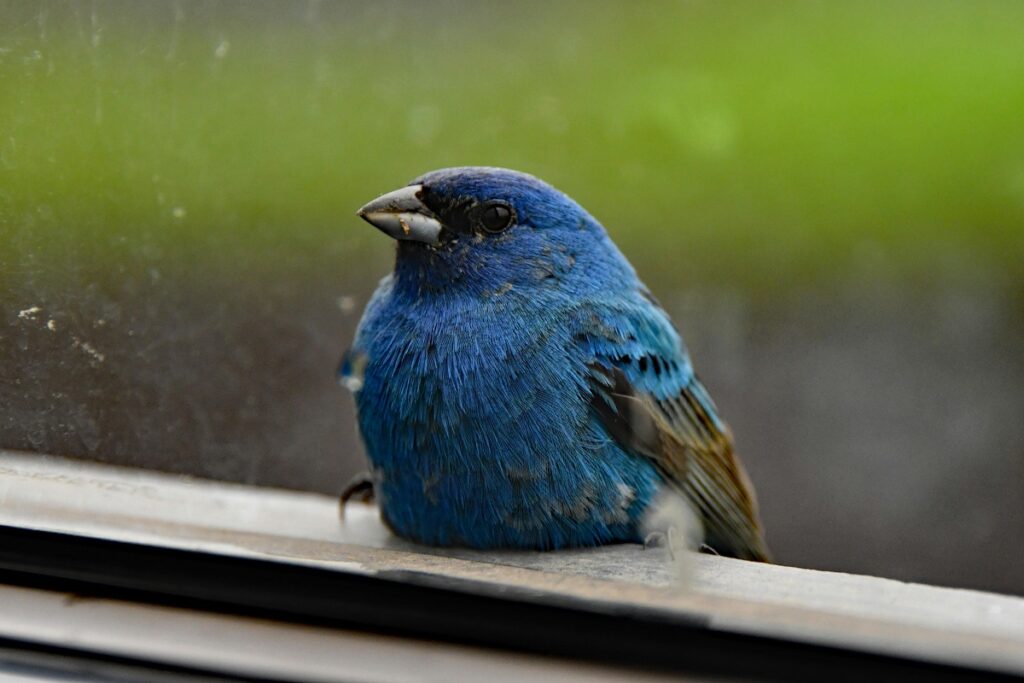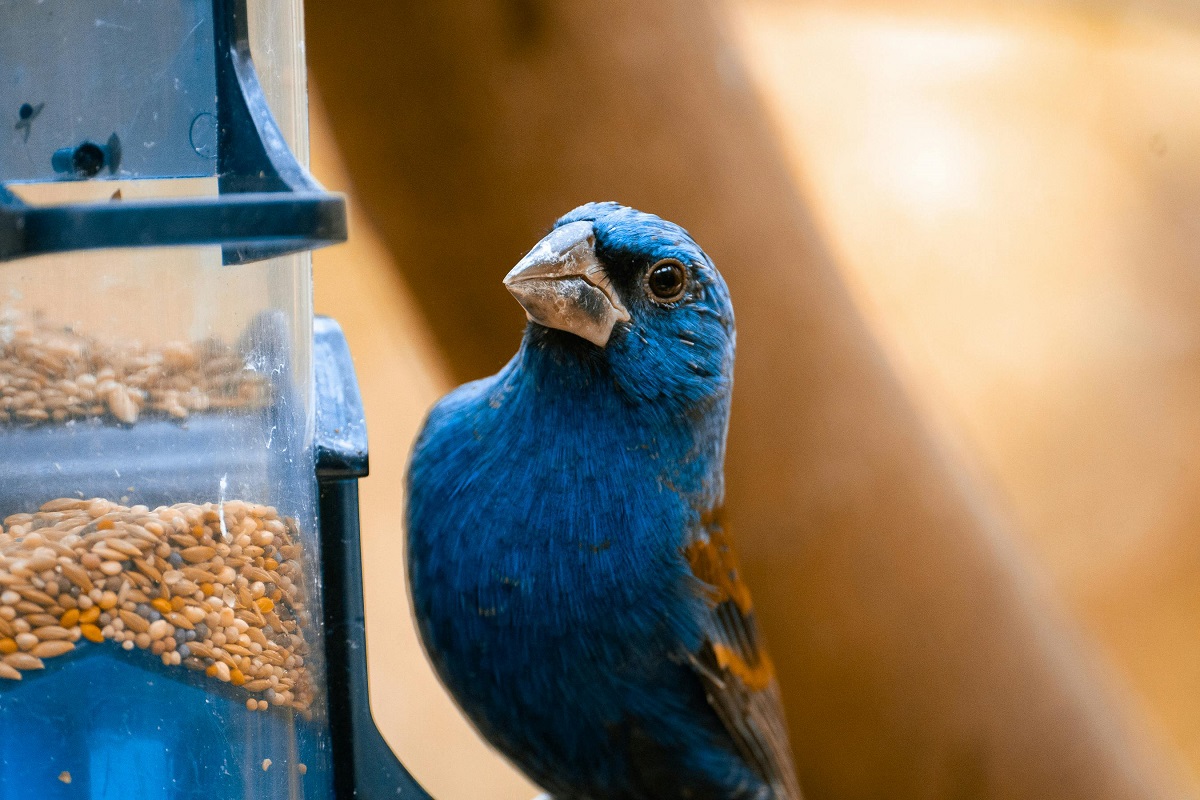The Blue Grosbeak is a small, colorful bird that captures the hearts of birdwatchers and nature lovers. With its bright blue feathers and unique song, this bird is a true gem of the wild. Found in parts of North and Central America, the Blue Grosbeak is a fascinating creature with many interesting traits. In this article, we will explore its appearance, habitat, behavior, diet, and more. Let’s dive into the world of the Blue Grosbeak and discover what makes it so special.
Breed Overview
| Category | Details |
|---|---|
| Scientific Name | Passerina caerulea |
| Class | Aves (Birds) |
| Order | Passeriformes (Perching Birds) |
| Family | Cardinalidae (Cardinal Family) |
| Size | 5.5 to 7.5 inches (14 to 19 cm) in length |
| Wingspan | 10 to 11 inches (25 to 28 cm) |
| Weight | 0.9 to 1.2 ounces (26 to 34 grams) |
| Lifespan | Up to 6-7 years in the wild |
| Color | Males: Bright blue with rusty wing bars; Females: Brown with blue tinges |
| Beak | Large, cone-shaped, silver-gray (adapted for cracking seeds) |
| Habitat | Open areas with shrubs, fields, roadsides, and near streams |
| Range | Breeds in the southern and central U.S.; winters in Mexico and Central America |
| Diet | Omnivore: Insects (grasshoppers, beetles), seeds, grains, and small fruits |
| Breeding Season | Spring and summer (April to August) |
| Nesting | Cup-shaped nest in shrubs or low trees; made of twigs, grass, and leaves |
| Clutch Size | 3 to 5 pale blue eggs |
| Incubation Period | About 12 days |
| Fledging Period | 9 to 12 days after hatching |
| Migration | Migratory: Winters in Central America and Mexico |
| Vocalization | Sweet, warbling song; sharp “chink” calls for communication |
| Predators | Hawks, snakes, raccoons, and domestic cats |
| Conservation Status | Least Concern (population stable but faces habitat loss and climate change) |
| Fun Fact | Males can mimic the songs of other birds, adding variety to their tunes |
What Does a Blue Grosbeak Look Like?

The Blue Grosbeak is a medium-sized songbird. Males are especially striking. They have deep blue feathers that shine in the sunlight. Their wings are darker, with hints of brown or black. A closer look reveals two bold, rusty-colored bars on their wings. Their large, cone-shaped beak is silver-gray, perfect for cracking seeds.
Females and young birds look different. They are mostly brown with some blue tinges on their wings and tails. This helps them blend into their surroundings, keeping them safe from predators. Both males and females have thick, strong beaks, so they are called “grosbeaks.” “grosbeak” comes from French, meaning “large beak.”
Where Can You Find Blue Grosbeaks?
Blue Grosbeaks live in open areas with lots of shrubs and scattered trees. They are often found in fields, along roadsides, and near streams. They like places where they can hide but also have a clear view of their surroundings. In the United States, they are common in the southern and central regions during the breeding season. In winter, they migrate to Central America and parts of Mexico.
These birds are not usually found in dense forests or cities. They prefer quieter, more natural spaces. If you want to spot a Blue Grosbeak, look for areas with tall grasses, bushes, and a few trees. They are often heard before they are seen, thanks to their beautiful songs.
The Blue Grosbeak’s Song and Calls
The Blue Grosbeak is known for its lovely, warbling song. Males sing to attract mates and defend their territory. Their song is a series of rich, musical notes that rise and fall in pitch. It is often described as sweet and cheerful. Sometimes, they mimic the sounds of other birds, adding variety to their songs.
Both males and females use calls to communicate. They have a sharp “chink” call to warn others of danger. They also use softer calls to stay in touch with their mates or chicks. Listening to a Blue Grosbeak’s song is a treat for anyone who loves birds.
What Do Blue Grosbeaks Eat?
Blue Grosbeaks are omnivores, which means they eat both plants and animals. Their diet changes with the seasons. In spring and summer, they eat mostly insects. They catch grasshoppers, beetles, caterpillars, and spiders. They are skilled hunters, often grabbing insects mid-air or picking them off plants.
In fall and winter, when insects are scarce, they switch to seeds and grains. Their strong beaks are perfect for cracking open tough seed shells. They also eat small fruits and berries. This varied diet helps them stay healthy and energetic throughout the year.
Nesting and Breeding Habits
Blue Grosbeaks are monogamous, meaning they pair up with one mate for the breeding season. Males arrive at the breeding grounds first. They sing loudly to attract females and establish their territory. Once a pair forms, they work together to build a nest.
The nest is usually hidden in a bush or low tree. It is made of twigs, grass, and leaves, and lined with softer materials like hair or feathers. The female lays 3 to 5 pale blue eggs. She incubates them for about 12 days while the male brings her food.
After the eggs hatch, both parents feed the chicks. The chicks grow quickly and leave the nest after 9 to 12 days. Even after leaving the nest, the young birds stay close to their parents for a few weeks. They learn to find food and avoid predators before becoming independent.
Migration Patterns
Blue Grosbeaks are migratory birds. They spend the spring and summer in the United States, where they breed. In late summer or early fall, they fly south to warmer areas. They spend the winter in Mexico, Central America, and sometimes as far south as Panama.
Migration is a dangerous time for these birds. They face many challenges, such as bad weather, predators, and lack of food. Despite these risks, Blue Grosbeaks are strong fliers. They travel hundreds or even thousands of miles to reach their winter homes.
Fun Facts About Blue Grosbeaks
Color Variations: Not all male Blue Grosbeaks are the same shade of blue. Some are brighter, while others are more muted. This depends on their age and health.
Mimicry: Blue Grosbeaks are talented mimics. They can copy the sounds of other birds, adding these notes to their songs.
Strong Beaks: Their large beaks are not just for eating. They also use them to break open snail shells and even small nuts.
Family Ties: Blue Grosbeaks are part of the cardinal family, which includes other colorful birds like Northern Cardinals and Indigo Buntings.
Lifespan: In the wild, Blue Grosbeaks can live up to 6 or 7 years. However, many do not survive their first year due to predators and other dangers.
How to Attract Blue Grosbeaks to Your Yard
If you want to see Blue Grosbeaks up close, you can try attracting them to your yard. Here are some tips:
Plant Native Shrubs: Blue Grosbeaks love areas with dense shrubs and bushes. Planting native species can provide them with shelter and nesting sites.
Offer Seeds: During the winter, you can put out bird feeders with sunflower seeds or millet. Blue Grosbeaks will visit if they feel safe.
Provide Water: A birdbath or small pond can attract Blue Grosbeaks, especially during hot weather.
Avoid Pesticides: Using fewer chemicals in your yard will help protect the insects that Blue Grosbeaks eat.
Be Patient: Blue Grosbeaks are shy birds. It may take time for them to feel comfortable visiting your yard.
The Science Behind Animal Migration How Birds and Fish Navigate the Globe

